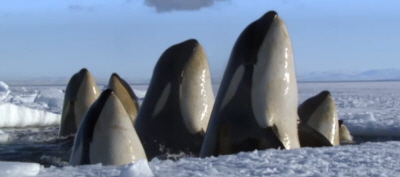Frozen Planet
To the Ends of the Earth
Over one third of our planet is frozen, yet the icy worlds of the Arctic and Antarctic are as alien to most of us as the surface of another planet.
They are places of superlatives. From ice-caps that hold nearly 80% of our planet's fresh water to frozen forests that encircle the entire globe. These are places that feed our imaginations, places that seem to be borrowed from fairytales. They're dominated and shaped by the ice. Both by it's coming and by it's going.
This is our planet's last true wilderness and one that is changing just as we're beginning to understand it. In this series we'll be travelling to all parts of these lonely lands, both north and south to witness it's wonders perhaps for the last time and to discover some extraordinary examples of survival against all the odds as can be found anywhere on the planet.
The poles are permanently capped with ice. Nowhere is colder, windier or more hostile to life. I'm standing at the north pole, the very top of the Earth. Up here it's easy to see why the polar regions are so cold. The sun never rises high enough in the sky to warm my back and those rays that do strike the surface are mostly reflected back from this great whiteness. But, the fundamental problem is that there's no sun here at all for half the year.

Inquisitive Orca
The polar winter is unrivalled in it's harshness. A night that lasts for months. Only the toughest stay as temperatures plunge to -70 degrees centigrade. And yet the greatest challenge to life here isn't the cold but the extreme swings between the seasons.
When the sun finally returns, an extraordinary transformation begins. This frozen world begins to melt away. The polar spring brings a brief opportunity for life
By summer, the sun no longer sets, and works it's magic for 24 hours a day. Now it's a race to breed before the sun departs. By Autumn, all but the hardiest abandon the poles and the ice extends it's grip. Land and sea close down for the long polar winter, until, once again, the sun returns.
Although it's Midsummerat at the South Pole, the temperature is a bone-chilling 35° below freezing. It's exactly 100 years, almost to the day, that the first human being stood right here, Amundsen followed by Scott. In those days, reaching the poles was regarded as the ultimate in human endeavour and endurance and was a source of great national pride. Today, the polar regions have a rather different significance, because, now we've come to understand that what happens here and in the North, affects everyone of us no matter where we live on this planet.

